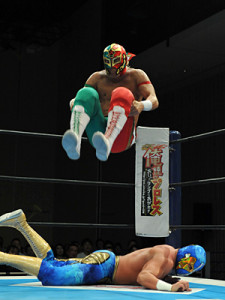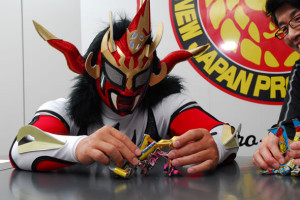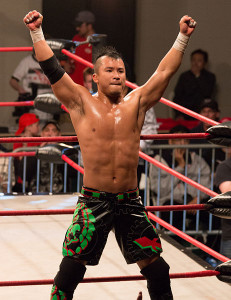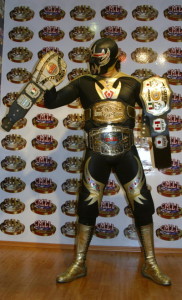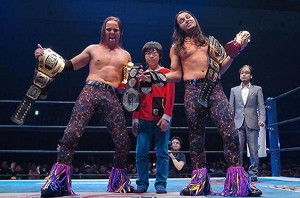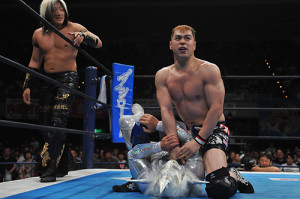It’s once again time for a major tournament in Japan. Last month was All Japan’s Champion Carnival: (Part 1 and Part 2). Now it’s New Japan’s turn to showcase the best Junior Heavyweights in the world, or at least that’s the premise. The first Best of the Super Juniors (there were 4 Top of the Super Jr’s but they aren’t included in the numbering) was held in 1994 and included some of the biggest stars of the era; like Jushin Liger, Wild “Chris Benoit” Pegasus, Black “Eddie Guerrero” Tiger II, Taka Michinoku, Dean Malenko, and David “Fit” Finlay. Ever since, the BOSJ has been the yearly event for Junior Heavyweights, with a few spots going to non-NJPW talents and the winner, if not already the IWGP Junior Heavyweight Champion, earning a title shot. The tournament is round robin style with 16 men divided in 2 blocks. There are 3 outside competitors this year: CMLL’s Mascara Dorada, DDT’s Kenny Omega, and Dragon Gate’s Kenny Omega. The current champion, Kota Ibushi who has been in the tournament the last 4 years including winning in 2011, won’t be in. Let’s take a look at our A Block participants.
Block A
Koslov was born in Moldova in 1984 and got his start in pro wrestling after being trained by Jesse Hernandez in 2003. He was on the West Coast of the U.S. working for independent companies like Pro Wrestling Guerrilla before getting his first international break in 2006 when he began working for CMLL as a heel or “rudo.” Koslov was the first Moldovan/Russian to wrestle in Arena Coliseo’s entire 70 year history. In 2008 Koslov got a lot of attention while participating in the ECWA Super 8 Tournament. Although he lost in the finals, his performance as a heel was so good that one fan threatened him with a chair. Also in 2008 he was able to to take part in TNA’s World X Cup due to his CMLL connections. Appearing as part of Team International, he appeared on TNA television and PPV introducing himself to the biggest American audience to date.
In October 2008 Koslov broke his handshake agreement with CMLL and debuted with rival promotion AAA. Koslov’s defection was so big in Mexico that not only was it compared to the Monday Night Wars but it made the front pages of many of Mexico’s newspapers. After debuting he formed the stable “D-Generation Mex” with Sean Waltman and Rocky Romero. On May 21, 2009 Koslov became the first ever AAA Cruiserweight Champion although he would only hold the title for under a month. During his second Cruiserweight reign and now a Rudo, Koslov lost a “Loser Leaves AAA” 6 Man Steel Cage Match and vacated his belt in August. However, Koslov would return in October as part of Konnan’s heel faction “La Legion Extranjera.” In June 2010 he would partner up with fellow Legionnaire Christina Von Eerie to win the AAA World Mixed Tag Team titles. They would hold the titles until October 1st, after losing the belts Koslov announced that he was leaving the company for WWE.
Koslov was sent to the WWE’s development territory in Florida where he was eventually given the name Peter Orlov. He was kept under contract until February 2012 but never sent up to the main roster and left the company at that time. In April 2012 Koslov would debut in NJPW appearing in his first Best of the Super Juniors, winning five of his round robin matches but finishing just out of reach advancing to the semi-finals. Koslov returned as a member of New Japan’s top heel unit “Chaos” in July and re-formed his AAA tag team with Rocky Romero as “Forever Hooligans.” The Hooligans had immediate success as a team, winning the IWGP Junior Heavyweight Tag Titles in July and holding them for nearly 4 months before losing them to the duo of Alex Shelley and KUSHIDA aka “Time Splitters.”
In 2013 Koslov traveled to Ring of Honor with Rockey Romero. Koslov had made a few appearances with ROH in the past with marginal success. On their first shows in March they failed in their attempts to defeat the American Wolves (Davey Richard and Eddie Edwards) and to gain the ROH World Tag Titles from ReDRagon (Bobby Fish and Kyle O’Reilly). After having regained the IWGP Junior Tag Titles from the Time Splitters in May, the Hooligans returned in July and successfully challenged for the ROH tag belts but only held them until the start of August, and have failed to regain them in subsequent appearances in ROH.
Back in Japan, Koslov would once again fail to advance past the round robin portion of the BOSJ tournament and would lose the IWGP Junior Tag belts in October 2013. Since then Koslov and Romero have been involved in the war between Chaos and rival stable Suzukigun and have failed to win the belts back despite several opportunities. Koslov isn’t likely to break his pattern of finishing just out of contention in this year’s BOSJ. He’s a solid wrestler but he isn’t someone that seems to be getting pushed as a singles star anytime soon.
BUSHI’s real name is Tetsuya Shimizu and he was trained in AJPW’s dojo by the legendary Animal Hamaguchi. When he first entered pro wrestling it was under the ring name “T28” which was inspired by the manga Tetsujin 28-go. He dressed up in a hip hop inspired outfit much like Dragon Gate’s M.c.KZ. After making his debut in 2007, Shimizu would get his first major wins in AJPW’s U-30 Tag Team Tournament teaming with KUSHIDA. Shimizu/KUSHIDA managed to win the one night only event. Hoping to replicate their success they entered AJPW’s Junior Tag League but finished in last. He would suffer similar dismal results when he entered the 2008 Junior League as a singles competitor. In late 2008 Shimizu was sent on the time honored “learning excursion” to Mexico that so many Japanese wrestlers before him had ventured on.
Once in Mexico Shimizu was trained in Lucha Libre by Skayde (non Lucha fans might know him from his many appearances in Chikara) and worked for IWRG under a mask as a Rudo not so creatively named “Tetsuya.” His name eventually morphed first to “Tetsuya Bushi” and then “Bushi” which was short for Japan’s famous Samurai code of Bushido. During his time in Mexico BUSHI won the IWRG Intercontinental Lightweight title twice, the first to accomplish that feat. After losing his title (and mask, as all good departing foreigners do) BUSHI left Mexico in January 2010.
Once back in AJPW and now as BUSHI (stipulations are not honored across international boundaries), he received a push teaming with Super Crazy and having a hard fought match for the Junior Heavyweight Title against Kaz Hayashi but lost. BUSHI and Super Crazy would win the 2010 Junior Tag League and continue to team regularly. AJPW would bring in an “evil” version of BUSHI called “Black Bushi” in August 2011 in an attempt to imitate the famous Mushiking Terry/Joker rivalry. Or Tiger Mask vs Black Tiger.
In April 2012 All Japan and New Japan announced that they had made a deal to have BUSHI switch companies in a “one year rental transfer” and he debuted in the 2012 BOSJ where he came in second to last in his block. BUSHI would also participate in the 2012 Super Jr Tag tournament and NEVER Openweight Championship tournament but failed to make an impact. BUSHI had done enough to impress New Japan officials into making his “rental transfer” a permanent transfer and in January 2013 they announced he had signed a contract to move over from All Japan. Since then, BUSHI has worked for CMLL as part of the NJPW/CMLL relationship under the name “Bushiroad” and was even positioned by CMLL as a technico (face) which is very rare for a Japanese wrestler. I don’t see this being BUSHI’s year to make it out of the round robin portion. The company seems to like him and he’s got plenty of time left but I don’t see him ever being one of the top guys in the division.
Deciding just what and how much to say about Liger was the most difficult thing for me going into this article. Jushin “Thunder” Liger is arguably the greatest junior heavyweight of all time and deserves an entire article of his own instead of a summation. That said, I’m going to give you a very brief sketch of Liger’s career and achievements, with a bit more on his early days since that might not be as well known.
Liger’s real name is Keiichi Yamada and after being an amateur wrestler in high school (and losing to All Japan legend Toshiaki Kawada in the finals of the National Championship) he tried to get into New Japan’s elite dojo but was rejected for being too small. Refusing to give up he left for Mexico and was eventually accepted by New Japan in 1984. Yamada was a success right from the start, going to the finals of the Young Lion Cup in 1985 before losing and then winning it the next year. One of his many claims to fame is that he innovated the Shooting Star Press, which he first used in 1987. He claimed he got the idea after reading the manga “Fist of the North Star.” While working for Stampede Wrestling in 1989 and training in the Hart Family dungeon, Yamada was urgently summoned back to Japan to take up the life altering gimmick of the anime superhero “Jushin Liger.”
The first ever match under the Jushin Liger gimmick was at the Tokyo Dome on April 24, 1989 where Liger defeated Kuniaki Kobayashi. From that moment on Liger only continued to gain in popularity and momentum. To give just a sample of Liger’s success in New Japan alone: 11x IWGP Junior Heavyweight Champion, 6x IWGP Junior Tag Champaion, and 2x Winner of the BOSJ in 1994 and 2001 (as well as in 1992 when it was the Top of the Super Juniors) and is one of only 5 men to hold the J-Crown (the unified 8 Junior Heavyweight Titles best remembered from WCW TV with Ultimo Dragon). That only scratches the surface of his accomplishments in wrestling. What makes it all the more remarkable is that Liger was forced to change his style from his more athletic high-flying ways to a more power oriented game mostly due to injuries and having survived surgery for a brain tumor in 1996.
For most of the last decade Liger has kept himself out of the title picture in New Japan though he is occasionally pushed back up the card (rarer and rarer the last few years), although he frequently wrestles in other companies both in Japan and around the world with great success. That said his best days are well behind him and while I don’t see him getting completely embarrassed I don’t see a miracle run either. Liger will have to console himself with the fact that he’s Jushin F’n Liger and he has the greatest theme song ever.
KUSHIDA started training to become a pro wrestler at Nobuhiko Takada’s dojo while still only a junior high schooler but first tried his hand at MMA with the ZST company. KUSHIDA made his MMA debut in June 2003 and between then and his last fight in January 2005 he complied a record of 6 wins, 0 losses, and 2 draws. Despite this impressive win/loss record KUSHIDA’s dream was to be a professional wrestler so in 2005 he left ZST and traveled to Mexico for further training in wrestling. After he returned to Japan in 2006 he signed with HUSTLE where he became a protege of Tajiri and one of the top young stars in the company.
In 2008 KUSHIDA teamed up with T28 (see Bushi above) to win AJPW’s one night only U-30 Tag tournament. KUSHIDA undertook his North American learning excursion in 2009 and 2010, wrestling in all 3 countries but especially seemed to enjoy his time in Canada (to this day his official twitter is @KUSHIDA_CANADA). When he came back to Japan he started working for SMASH, Tajiri’s HUSTLE offshoot (HUSTLE had sadly gone out of business). Also in 2010 KUSHIDA would get the biggest break so far in his career when he was invited by New Japan to take part in the BOSJ where he would win 4 of his 7 matches leaving him just out of contention for the Semi Finals, an impressive performance for a first timer.
KUSHIDA would be invited back to take part in the brand new Super J Tag League where he teamed with Gedo and made it all the way to the Semi Finals before being eliminated. KUSHIDA then teamed with Tanahashi and Tajiri in a 6-man Tournament but lost in the finals. New Japan clearly had a great deal of interest in KUSHIDA so it wasn’t shocking when in February 2011 it was announced he was leaving SMASH with Tajiri’s blessing to work full-time for New Japan. In 2011 KUSHIDA would once again compete in the various Junior tournaments but would fail to win. He would also receive his first ever chances to win the IWGP Junior Heavyweight Title and IWGP Tag team Titles but was also also defeated.
In 2012 during New Japan’s first ever tour of the U.S. KUSHIDA formed a partnership with Alex Shelley after saving him from the Forever Hooligans and took on the name “Time Splitters.” In October 2012 Time Splitters won the Super Jr Tag League and became the Number #1 contenders for Junior Tag Titles. On November 11 they would win the titles and hold them until May 2013. In the 2013 BOSJ KUSHIDA would once again finish just out of contention for the semi’s. In August KUSHIDA made his first ever appearance for Ring of Honor before returning to Japan where he and Shelley earned a rematch for the IWGP Tag Titles. Unfortunately they were forced to pull out after Shelley was injured.
Shelley would return at the 2014 January Tokyo Dome show where the Time Splitters would fail in their bid to regain the titles, but would succeed in their awesome Back to the Future cosplay, with Delorean. Since then Time Splitters have continued to be fight for the tag titles, including at the New Japan/ROH show on May 10th. I think KUSHIDA stands a pretty good chance of breaking his curse of never making it out of the round robin portion this year, especially with the current champion not participating. KUSHIDA is one of the wrestlers New Japan will be building the division around in the future and now that Devitt is gone and many of the others are just getting older (Liger, Tiger Mask) they need to rebuild.
The man who would be best known as Mascara Dorada has never had his real name revealed to the public as is traditional for many masked luchadors. He is 25 years old and debuted in 2006 (or possibly early 2007) after being trained by Gran Cochisse and El Satanico. His first identity was “Plata II” which didn’t last long before being given a new look and name as “Metalik.” He quickly started working his way up with CMLL, participating in the Torneo Gran Alternativa which has a veteran (in this case Dos Caras Jr) team up with a newcomer. Caras and Metalik made it all the way to the finals before losing.
In 2007 CMLL had signed Mascarita Sagrada 2000 a very popular and talented “mini” wrestler (He’s now El Torito in WWE) but were not legally allowed to call him by that name anymore. So they renamed him “Mascarita Dorada.” Mascarita was so popular CMLL decided in 2008 to repackage a full-size wrestler to partner up with him (usually the reverse happens) and Metalik was chosen to become “Mascara Dorada” debuting under the gimmick in November 2008. In April 2009 Mascara won the CMLL World Super Lightweight Championship by being the last man standing out of 10 men in a “Tornero Cibernetico” match. Mascara would continue his winning ways in January 2010 when his 6-man team won a tournament to crown new 6-man champion. Then in February, Mascara and his heel partner, Atlantis won the “Torneo Nacional de Parejas Increibles” where CMLL teams up a face and a heel.
Mascara would accomplish a first in CMLL in September 2010 when he defeated Negro Casas for the CMLL World Welterweight Title and become the first ever Quadruple Champion although he would soon after vacate his portion of the Trios title and in January 2011 lost the Welterweight belt. Mascara and Atlantis would win the “Parejas Increibles” tournament for the second year in a row in February. Mascara vacated his Lightweight Title to move up to the Middleweight division in April 2011 has continued to be successful including winning the NWA World Historic Welterweight Championship in 2013.
New Japan first brought Mascara over to work for them in May 2010 for their first ever Super J Tag Team Tournament where he would team with fellow luchador Valiente. They would lose in the first round but Mascara was clearly not done with New Japan, or they with him. In November he was invited back for the Super J Tag League where this time he teamed with a different luchador, La Sombra. The masked men had more success finishing third in their block but still falling short of the finals. Mascara would work a number of tours for New Japan throughout 2011 including a failed attempt in May to beat Liger for the CMLL World Middleweight Title. He would also take part in the 2011 BOSJ but finish out of contention for advancement. He would, however, defeat Ryusuke Taguchi in June to regain the World Welterweight Title.
Mascara would return in 2012 and 2013 as the New Japan/CMLL partnership continued to flourish taking part in both years’ “Fantasticamania” joint produced shows as well as touring several times although he would not take part in another BOSJ or Tag League. He’s back for this year’s BOSJ and don’t expect him to win. Mascara isn’t around enough for him winning to make sense. He’ll be one of the many guys in the tangle that just miss advancing.
See the next article for a joint profile on both Young Bucks.
The daredevil know as Ricochet has already had a tremendously successful career in Japan and is only 25 years old. Ricochet debuted in 2003 but didn’t start competing regularly until 2006, probably because of all that homework getting in the way. Once he began working regularly he immediately earned a reputation for taking risks and being an incredibly high flyer. Cemented when on April 1st in a 9-man TLC match he performed his finisher, a Double Rotation Moonsault off a ladder out of the ring onto the other men. He still lost the match but he wrestled again later the same day.
In June of 2006 Ricochet debuted with Chikara losing in the first round of the Young Lions Cup. He continued to work for the company throughout 2006 and 2007 often feuding with Chuck Taylor, including losing to Taylor in the finals of the 2007 Young Lions Cup. Finally the two men met in a match that pitted Ricochet’s career Vs. Taylor’s Cup in August 2007 but Ricochet once again lost to his nemesis and was forced to leave Chikara seemingly for good. This is pro wrestling so in October Ricochet returned with a new look and a mask and was now known as “Helios” and defeated Chuck Taylor for the Young Lions Cup, which he would hold until June 2008. In 2010 he left Chikara to work for Dragon Gate and Dragon Gate USA full-time.
Ricochet debuted with Dragon Gate USA in July 2010 at the very first show and obviously impressed the right people because at the next show in September he was made a member of the “Warriors International” stable by its leader (and the company’s top man) CIMA. In September 2011 CIMA and Ricochet won the Open The United Gate Championships (tag titles) but had to vacate them in March 2012 when CIMA was sidelined with a neck injury. Ricochet would team up with Masato Yoshino to regain the belts but the very next month in June the duo would be stripped of the belts because Yoshino was unable to appear at the shows. In April 2014 Ricochet defeated Johnny Gargano to win the company’s top singles belt the Open the Freedom Gate.
Due to his stellar work for the American version of Dragon Gate, Ricochet landed his first tour of Japan in December 2010 and he made a big impact on the tour winning the 6-man title (Open the Triangle Gate) with CIMA and Dragon Kid. In July 2011 Ricochet and CIMA won the Open the Twin Gates (I think you can guess what those are) which they held until November when they vacated it to allow them to focus on singles competition which clearly worked because he finally defeated his rival PAC that month to win the company’s secondary singles title the Open the Brave Gate and prove he was the best high flyer (at least to himself).
In February 2012 after one of the many unit shakeups that are part of life in Dragon Gate, Ricochet joined Yoshino and Naruki Doi’s new World-1 International and parted ways peacefully with his mentor CIMA. Although May 2013 started poorly for Ricochet when he lost his Brave Gate it ended on a great note as he won the King of Gate Tournament, a first for a foreign talent in Dragon Gate. By winning the tournament he earned a shot at the top title, the Open the Dream Gate which was held by none other than CIMA but he was unable to beat his former partner who was in the middle of a monster title run. In July 2013 would once again win the Twin Gates, this time partnering with Naruki Doi but they would only hold them for a month. Ricochet’s biggest career achievement would come in March 2014 when he defeated Masato Yoshino to become the only foreigner to ever hold the Open the Dream Gate Title which is a huge accomplishment. Ricochet would lose the title in May.
New Japan invited Ricochet to the 2013 BOSJ where he won 5 of his 8 matches but finished just out of contention for the semi’s. I’d be down with Ricochet making it to the semi’s this year but I don’t know about that happening. I think that after the great year he’s had he has a better chance of it but I definitely don’t see New Japan having him win the tournament.
TAKA Michinoku’s real name is actually Takao Yoshida, he took the name TAKA Michinoku to show respect to his trainer The Great Sasuke who owned the Michinoku Pro Wrestling company and had himself once used Michinoku in his ring name (as Masa Michinoku). TAKA would make his wrestling debut in 1992 while still only 18. TAKA would participate in the famous Super J Cup 1994 although he was eliminated in the first round. He was impressive enough that he would be invited by New Japan to take part in that year’s BOSJ where he managed to secure only one victory. While working for MPRO, TAKA would become a member of the famous Kai En Tai DX stable along with: Sho Funaki, Dick Togo, Kaz Hayashi, and Men’s Teioh. The stable would set the bar for high-end lucha inspired wrestling in Japan (lucharesu if you will) with their feuds with MPRO’s top babyfaces like Great Sasuke, Super Delfin, and Gran Hamada. TAKA’s first title reign would come in 1996 when he won the FMW Independent Junior Heavyweight Championship which he would hold for 13 months, starting a career long trend of holding titles for long periods.
TAKA made his first appearance in the United States in February 1997 with ECW teaming with fellow Kai En Tai members Dick Togo and Terry Boy (Men’s Teioh) as part of bWo Japan. The unit would appear on ECW’s first ever PPV, Barely Legal 1997. Bigger things were in store for TAKA though because on July 6th 1997 he made his debut for the then named WWF at the Canadian Stampede PPV where he wrestled his mentor Great Sasuke in a match he lost. But got a huge reaction from the crowd for his style, which impressed the WWF brass. They would have a re-match on the next night’s Monday Night Raw that led to the WWF selecting TAKA (over The Great Sasuke) to enter into the tournament to crown the WWF Light Heavyweight Champion and on December 7th, 1997 he would win the title, holding it for 10 months before losing it to Christian.
On March 30th 1998, Funaki, Dick Togo and Men’s Teioh debuted and attacked TAKA. They were originally called Club Kamikaze but the WWF changed their minds and had the unit’s new manager, Yamaguchi-San, announce they were called Kai En Tai. TAKA allied with Val Venis who during all this filmed a sex tape with Mrs. Yamaguchi which first caused the infamous “I choppy choppy your pee pee” segment and then secondly had TAKA turn on Val and join Kai En Tai because Mrs Yamaguchi was TAKA’s sister. Full Russo was in effect.
Soon after, all the members of the faction but TAKA and Funaki left the company which left the duo to become a comedy tag team best known for their “We are EVIL” … “INDEED” skits where their voices were intentionally badly dubbed over. TAKA’s biggest moment in the company was on the April 10, 2000 Raw when HHH, in an incredible performance actually made everyone believe he was about to lose the WWF Championship to TAKA before crushing that hope. TAKA would leave the WWE in 2002 and return to Japan.
After returning to Japan TAKA would found his own small company, Kaientai Dojo, which actually started in 2000 as a wrestling school in Puerto Rico. TAKA would debut for All Japan in August 2003 where he started the RO&D (Roughly Obsess and Destroy) stable. Originally a faction of heels, RO&D would become the company’s big face faction and feud with the companies never ending unit of heels the VOODOO MURDERS. In January 2005 TAKA defeated his former Kai En Tai ally Kaz Hayashi to win the AJPW World Junior Heavyweight Championship, holding the title until October. RO&D would disband in 2006 leading to a new phase in TAKA’s All Japan career as he became “Pepe” Michinoku along with El Nosawa Mendoza and Miguel Hayashi as part of Mexico Amigos. TAKA would continue wrestling for All Japan throughout 2008 and 2009 but wouldn’t pick up any more titles.
TAKA and his old partner Dick Togo teamed up together in New Japan to win the IWGP Junior Heavyweight Tag Titles in May 2007 but only held the belt for a few months. TAKA returned to New Japan in 2010 and joined Satoshi Kojima’s heel stable. When Kojima lost the IWGP Heavyweight Title, TAKA and fellow stablemate Taichi soon lost patience with their leader and on May 2011 they turned on Kojima and after the surprise return of Minoru Suzuki they formed “Suzukigun.” TAKA took part in the 2011 and 2012 BOSJ’s but didn’t make it out of the round robin sections. TAKA and Taichi would team up in the Super Junior Tag tournament in 2012 and make it the semi finals before being eliminated by the Time Splitters.
In 2013 TAKA would have his most successful BOSJ when an injury would take Ryusuke Taguchi out of the tournament and advance TAKA to the semi finals. Unfortunately for him, TAKA was unable to capitalize on this opportunity and was eliminated. TAKA would benefit from another injury though, this time to Alex Shelley which would allow him and Taichi to get a tag title shot at Forever Hooligans in October. TAKA and Taichi managed to beat the Hooligans and became the IWGP Junior Heavyweight Tag champs but only held the belts for a month. TAKA will do as well as he does every other year (aside from last year which was a fluke) and finish in the middle of the pack. His best years were spent in the WWF and now he’s in the slot where he makes others look good and he does it very well.
That’s it for now but make sure to join me next time as we take a look at the B Block. Thanks for reading!


